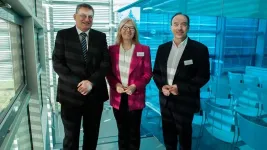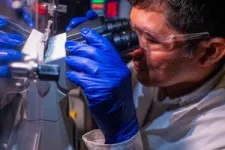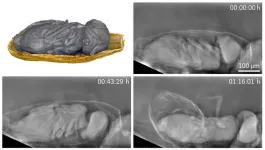(Press-News.org) The University of Stuttgart and Hewlett Packard Enterprise (HPE) have announced an agreement to build two new supercomputers at the High-Performance Computing Center of the University of Stuttgart (HLRS).
In the first stage, a transitional supercomputer, called Hunter, will begin operation in 2025. This will be followed in 2027 with the installation of Herder, an exascale system that will provide a significant expansion of Germany’s high-performance computing (HPC) capabilities. Hunter and Herder will offer researchers world-class infrastructure for simulation, artificial intelligence (AI), and high-performance data analytics (HPDA) to power cutting-edge academic and industrial research in computational engineering and the applied sciences.
The total combined cost for Hunter and Herder is €115 million. Funding will be provided through the Gauss Centre for Supercomputing (GCS), the alliance of Germany's three national supercomputing centers. Half of this funding will be provided by the German Federal Ministry of Education and Research (BMBF), and the second half by the State of Baden-Württemberg's Ministry of Science, Research, and Arts.
Hunter to Herder: a two-step climb to exascale
Hunter will replace HLRS’s current flagship supercomputer, Hawk. It is conceived as a stepping stone to enable HLRS’s user community to transition to the massively parallel, GPU-accelerated structure of Herder.
Hunter will be based on the HPE Cray EX4000 supercomputer, which is designed to deliver exascale performance to support large-scale workloads across modeling, simulation, AI, and HPDA. Each of the 136 HPE Cray EX4000 nodes will be equipped with four HPE Slingshot high-performance interconnects. Hunter will also leverage the next generation of Cray ClusterStor, a storage system purpose-engineered to meet the demanding input/output requirements of supercomputers, and the HPE Cray Programming Environment, which offers programmers a comprehensive set of tools for developing, porting, debugging, and tuning applications.
Hunter will raise HLRS’s peak performance to 39 petaFLOPS (39*1015 floating point operations per second), an increase from the 26 petaFLOPS possible with its current supercomputer, Hawk. More importantly, it will transition away from Hawk’s emphasis on CPU processors to make greater use of more energy-efficient GPUs.
Hunter will be based on the AMD Instinct™ MI300A accelerated processing unit (APU), which combines CPU and GPU processors and high-bandwidth memory into a single package. By reducing the physical distance between different types of processors and creating unified memory, the APU enables fast data transfer speeds, impressive HPC performance, easy programmability and great energy efficiency. This will slash the energy required to operate Hunter in comparison to Hawk by approximately 80% at peak performance.
Herder will be designed as an exascale system capable of speeds on the order of one quintillion (1018) FLOPS, a major leap in power that will open exciting new opportunities for key applications run at HLRS. The final configuration, based on accelerator chips, will be determined by the end of 2025.
The combination of CPUs and accelerators in Hunter and Herder will require that current users of HLRS’s supercomputer adapt existing code to run efficiently. For this reason, HPE will collaborate with HLRS to support its user community in adapting software to harness the full performance of the new systems.
Supporting scientific excellence in Stuttgart, Germany, and beyond
HLRS's leap to exascale is part of the Gauss Centre for Supercomputing's national strategy for the continuing development of the three GCS centers: The upcoming JUPITER supercomputer at the Jülich Supercomputing Centre will be designed for maximum performance and will be the first exascale system in Europe in 2025, while the Leibniz Supercomputing Centre is planning a system for widescale usage in 2026. The focus of HLRS’s Hunter and Herder supercomputers will be on computational engineering and industrial applications. Together, these systems will be designed to ensure that GCS provides optimized resources of the highest performance class for the entire spectrum of cutting-edge computational research in Germany.
For researchers in Stuttgart, Hunter and Herder will open many new opportunities for research across a wide range of applications in engineering and the applied sciences. For example, they will enable the design of more fuel-efficient vehicles, more productive wind turbines, and new materials for electronics and other applications. New AI capabilities will open new opportunities for manufacturing and offer innovative approaches for making large-scale simulations faster and more energy efficient. The systems will also support research to address global challenges like climate change, and could offer data analytics resources that help public administration to prepare for and manage crisis situations. In addition, Hunter and Herder will be state-of-the-art computing resources for Baden-Württemberg’s high-tech engineering community, including the small and medium-sized enterprises that form the backbone of the regional economy.
Statements
Mario Brandenburg (Parliamentary State Secretary, Federal Ministry for Education and Research, BMBF)
“Funded by the BMBF and the State of Baden-Württemberg, the expansion of the computing infrastructure of the Gauss Centre for Supercomputing at its Stuttgart location is an important step on the road to more computing power for Germany’s research and innovation landscape. The unique concept behind the computing architecture at HLRS will ensure that not just science but also industry, SMEs, and start-ups will have first-class conditions developing new innovations. This expansion also means increased computing capacity for the development of AI and a strengthening of Germany’s AI infrastructure, in accordance with the federal research ministry’s AI action plan.“
Petra Olschowski (Baden-Württemberg Minister of Science, Research, and Arts)
“High-performance computing means rapid development. As the peak performance of supercomputers grows, they are as crucial for cutting-edge science as for innovative products and processes in key industrial sectors. Baden-Württemberg is both a European leader and internationally competitive in the fields of supercomputing and artificial intelligence. As part of the University of Stuttgart, HLRS thus has a key role to play — it is not just the impressive performance of the supercomputer but also the methodological knowledge that the center has assembled that helps our cutting-edge computational research to achieve breathtaking results, for example in climate protection or for more environmentally sustainable mobility.“
Prof. Dr. Wolfram Ressel (Rector, University of Stuttgart)
“With Hunter and Herder, the University of Stuttgart continues its commitment to high-performance computing as the foundation of its successful excellence strategy. This expansion will especially strengthen Stuttgart’s leading position in research using computer simulation and artificial intelligence.”
Anna Steiger (Chancellor, University of Stuttgart)
“Supporting cutting-edge science while maximizing energy efficiency is a central concern for everyone at the University of Stuttgart. Hunter and Herder constitute a decisive reaction to the challenges of limiting CO2 emissions, and Herder will deliver not only dramatically higher computing performance but also excellent energy performance.”
Prof. Dr. Michael Resch (Director, High-Performance Computing Center Stuttgart)
“HPE has been a reliable partner since 2019, and we are excited to be making the jump with them to the next order of magnitude in computing performance, the exaFLOP. Using GPU technology from AMD, we are also confident that we will be well prepared for the challenges of the future.”
Justin Hotard (Executive Vice President and General Manager, HPC, AI & Labs, Hewlett Packard Enterprise)
“HLRS has demonstrated the power of supercomputing in research and applied science, and we are honored to have been with them on this journey. We look forward to building on our collaboration to pave the way to exascale for HLRS using the HPE Cray EX supercomputer. The new system will enable scientific and technological innovation to accelerate economic growth.”
Mario Silveira (Corporate Vice President OEM Sales, AMD)
”AMD is pleased to expand our collaboration with HLRS in Stuttgart and HPE. We are providing our cutting-edge AMD Instinct™ MI300A datacenter accelerator to the Hunter project, aiming to enhance performance, efficiency, and data transfer speeds. This initiative will establish a state-of-the-art infrastructure tailored for research, AI workloads, and simulations. Anticipated for arrival by 2025, Hunter aligns with HLRS's ambitious exascale plans for Germany, showcasing our commitment to advancing technological capabilities and fostering innovation together with our partners in the years to come.”
Dr. Bastian Koller (General Manager, HLRS)
“Increasingly it’s not just faster hardware but optimal usage of the system that is the greatest performance factor in simulation and artificial intelligence. We are particularly excited that we have found a globally leading partner for these topics in Hewlett Packard Enterprise, who together with AMD will open up new horizons of performance for our clients.”
About the High-Performance Computing Center Stuttgart
The High-Performance Computing Center Stuttgart (HLRS) was established in 1996 as the first German national high-performance computing center, building on a tradition of supercomputing at the University of Stuttgart that stretches back to 1959. As a research institution affiliated with the University of Stuttgart and a founding member of the Gauss Centre for Supercomputing — the alliance of Germany's three national supercomputing centers — HLRS provides state-of-the-art HPC services to academic users and industry. HLRS operates one of Europe's most powerful supercomputers, provides advanced training in HPC programming and simulation, and conducts research to address key problems facing the future of supercomputing. Among HLRS's areas of expertise are parallel programming, numerical methods for HPC, visualization, cloud computing concepts, high-performance data analytics (HPDA), and artificial intelligence. Users of HLRS computing systems are active across a wide range of disciplines, with an emphasis on computational engineering and applied science.
END
High Performance Computing Center of the University of Stuttgart and Hewlett Packard Enterprise to build exascale supercomputer
The two organizations announced an agreement to build two supercomputers at HLRS: Hunter and Herder
2023-12-19
ELSE PRESS RELEASES FROM THIS DATE:
Gentle x-ray imaging of small living specimens
2023-12-19
X-ray imaging visualizes hidden structures and processes in living cells and organisms. The radiation that consists of highly energy-rich electromagnetic waves, however, has an ionizing effect and may damage the genetic material. This limits the possible observation period. While conventional X-ray images of soft tissue are of low contrast, phase contrast methods produce far better image contrasts at a reduced radiation dose. With higher resolution, however, gentle imaging becomes increasingly difficult, as a higher dose is required. Moreover, ...
Pushing compressed sensing to real-time edge applications
2023-12-19
Recently, a research team led by Prof. Sun Zhong at Peking University reported an analog hardware solution for real-time compressed sensing recovery, which has been published as an article titled "In-memory analog solution of compressed sensing recovery in one step" in Science Advances. In this work, a design based on a resistive memory (also known as memristor) array for performing instantaneous matrix-matrix-vector multiplication (MMVM) is first introduced. Based on this module, then an analog matrix computing circuit that solves compressed sensing (CS) recovery in one step (within few microseconds) is disclosed.
CS ...
The science behind snowflakes
2023-12-19
Tim Garrett has devoted his scientific career to characterizing snowflakes, the protean particles of ice that form in clouds and dramatically change as they fall to Earth.
Now the University of Utah atmospheric scientist is unlocking the mystery of how snowflakes move in response to air turbulence that accompanies snowfall using novel instrumentation developed on campus. And after analyzing more than half a million snowflakes, what his team has discovered has left him astonished.
Rather than something incomprehensibly complicated, predicting how snowflakes move proved to be surprisingly ...
COVID-19 infection causes teen’s vocal cord paralysis in first-of-its-kind case
2023-12-19
Physician-researchers from Mass Eye and Ear, a member of Mass General Brigham, report the first pediatric case of bilateral vocal cord paralysis after COVID-19 (SARS-CoV-2) infection. The patient, an otherwise healthy 15-year-old female, came to the emergency department at Massachusetts General Hospital with symptoms of respiratory distress nine days after diagnosis with SARS-CoV-2 infection. Examination with an endoscope revealed bilateral vocal cord paralysis, which is an immobility of both vocal cords found in the larynx or voice box. The researchers concluded that this paralysis was likely a downstream ...
Vervet monkeys follow different social “norms” and respond to “peer pressure,” new long-term study shows
2023-12-19
People living in different communities follow different social customs or norms. In some places, for instance, it might be standard practice to greet each person you see on the street, while in others that simply isn’t done. In some cases, such differences may even vary from one neighborhood to the next. Now researchers reporting in the journal iScience on December 19 have found similarly varied social traditions and styles among neighboring groups of vervet monkeys.
“We report the existence of behavioral traditions of social customs in vervet ...
Would you like to groom me?
2023-12-19
Researchers at UNIL’s Department of Ecology and Evolution reveal the existence of social traditions in vervet monkeys. This work was published in iScience on December 19, 2023.
British tits have learned from each other how to pierce the lids of milk bottles left on doorsteps. On the island of Koshima, Japanese macaques started washing sweet potatoes to rid them of sand. The animal realm is full of examples of traditions linked to food, tool use or hunting techniques that have spread within specific communities. However, few traditions of social nature, i.e. how individuals interact with each other, have been described.
A ...
Snowflakes swirling in turbulent air as they fall through a laser light sheet. Credit: Singh et al.
2023-12-19
WASHINGTON, Dec. 19, 2023 – A winter wonderland calls to mind piles of fluffy, glistening snow. But to reach the ground, snowflakes are swept into the turbulent atmosphere, swirling through the air instead of plummeting directly to the ground.
The path of precipitation is complex but important to more than just skiers assessing the potential powder on their alpine vacation or school children hoping for a snow day. Determining snowflake fall speed is crucial for predicting weather patterns and measuring climate ...
Clinicians could be fooled by biased AI, despite explanations
2023-12-19
AI models in health care are a double-edged sword, with models improving diagnostic decisions for some demographics, but worsening decisions for others when the model has absorbed biased medical data.
Given the very real life and death risks of clinical decision-making, researchers and policymakers are taking steps to ensure AI models are safe, secure and trustworthy—and that their use will lead to improved outcomes.
The U.S. Food and Drug Administration has oversight of software powered by AI and machine learning used in health care and has issued guidance for developers. This includes a call to ensure the ...
Measuring the impact of AI in the diagnosis of hospitalized patients
2023-12-19
About The Study: Although standard artificial intelligence (AI) models improve diagnostic accuracy, systematically biased AI models reduced diagnostic accuracy, and commonly used image-based AI model explanations did not mitigate this harmful effect in this multicenter randomized clinical vignette survey study involving hospitalist physicians, nurse practitioners, and physician assistants from 13 states.
Authors: Michael W. Sjoding, M.D., of the University of Michigan Medical School, and Jenna Wiens, Ph.D., of the University of Michigan, Ann Arbor, are the corresponding authors.
To ...
Disparities in preoperative goals of care documentation in veterans
2023-12-19
About The Study: In this study of 13,000 patients, few patients undergoing surgical procedures completed preoperative life-sustaining treatment documentation, with disparities in documentation rates based on race, ethnicity, rurality of patient residence, history of mental health disability, and access to high-volume facilities within a Veterans Affairs cohort.
Authors: Adela Wu, M.D., of the U.S. Department of Veterans Affairs, in Palo Alto, California is the corresponding author.
To access the embargoed study: Visit our For The Media website at this link https://media.jamanetwork.com/
(doi: ...
LAST 30 PRESS RELEASES:
Scientists trace microplastics in fertilizer from fields to the beach
The Lancet Obstetrics, Gynecology, & Women’s Health: Taking paracetamol during pregnancy does not increase risk of autism, ADHD or intellectual disabilities, confirms new gold-standard evidence review
Taking paracetamol during pregnancy does not increase risk of autism, ADHD or intellectual disabilities
Harm reduction vending machines in New York State expand access to overdose treatment and drug test strips, UB studies confirm
University of Phoenix releases white paper on Credit for Prior Learning as a catalyst for internal mobility and retention
Canada losing track of salmon health as climate and industrial threats mount
Molecular sieve-confined Pt-FeOx catalysts achieve highly efficient reversible hydrogen cycle of methylcyclohexane-toluene
Investment in farm productivity tools key to reducing greenhouse gas
New review highlights electrochemical pathways to recover uranium from wastewater and seawater
Hidden pollutants in shale gas development raise environmental concerns, new review finds
Discarded cigarette butts transformed into high performance energy storage materials
Researchers highlight role of alternative RNA splicing in schizophrenia
NTU Singapore scientists find new way to disarm antibiotic-resistant bacteria and restore healing in chronic wounds
Research suggests nationwide racial bias in media reporting on gun violence
Revealing the cell’s nanocourier at work
Health impacts of nursing home staffing
Public views about opioid overdose and people with opioid use disorder
Age-related changes in sperm DNA may play a role in autism risk
Ambitious model fails to explain near-death experiences, experts say
Multifaceted effects of inward foreign direct investment on new venture creation
Exploring mutations that spontaneously switch on a key brain cell receptor
Two-step genome editing enables the creation of full-length humanized mouse models
Pusan National University researchers develop light-activated tissue adhesive patch for rapid, watertight neurosurgical sealing
Study finds so-called super agers tend to have at least two key genetic advantages
Brain stimulation device cleared for ADHD in the US is overall safe but ineffective
Scientists discover natural ‘brake’ that could stop harmful inflammation
Tougher solid electrolyte advances long-sought lithium metal batteries
Experts provide policy roadmap to reduce dementia risk
New 3D imaging system could address limitations of MRI, CT and ultrasound
First-in-human drug trial lowers high blood fats
[Press-News.org] High Performance Computing Center of the University of Stuttgart and Hewlett Packard Enterprise to build exascale supercomputerThe two organizations announced an agreement to build two supercomputers at HLRS: Hunter and Herder






